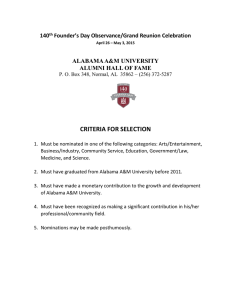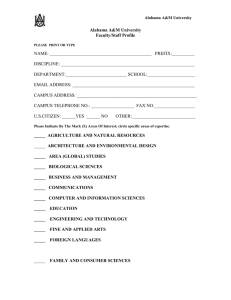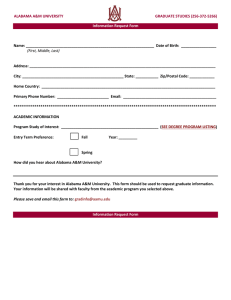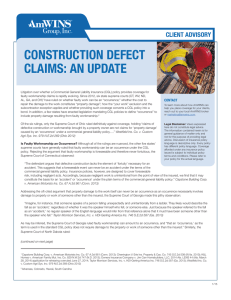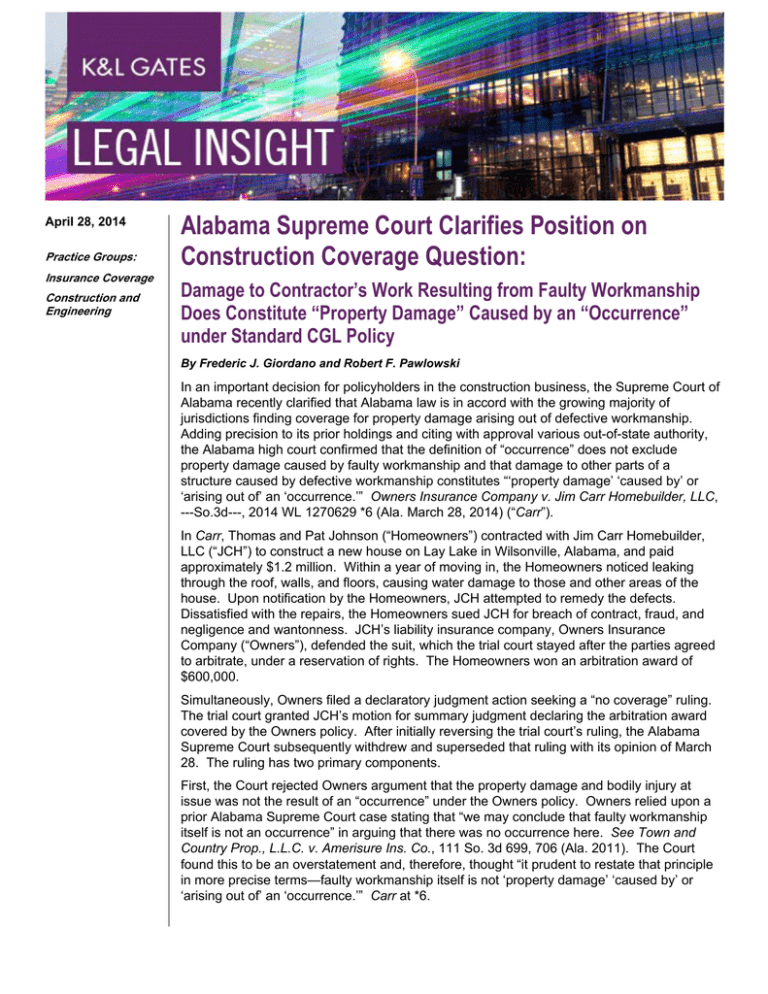
April 28, 2014
Practice Groups:
Insurance Coverage
Construction and
Engineering
Alabama Supreme Court Clarifies Position on
Construction Coverage Question:
Damage to Contractor’s Work Resulting from Faulty Workmanship
Does Constitute “Property Damage” Caused by an “Occurrence”
under Standard CGL Policy
By Frederic J. Giordano and Robert F. Pawlowski
In an important decision for policyholders in the construction business, the Supreme Court of
Alabama recently clarified that Alabama law is in accord with the growing majority of
jurisdictions finding coverage for property damage arising out of defective workmanship.
Adding precision to its prior holdings and citing with approval various out-of-state authority,
the Alabama high court confirmed that the definition of “occurrence” does not exclude
property damage caused by faulty workmanship and that damage to other parts of a
structure caused by defective workmanship constitutes “‘property damage’ ‘caused by’ or
‘arising out of’ an ‘occurrence.’” Owners Insurance Company v. Jim Carr Homebuilder, LLC,
---So.3d---, 2014 WL 1270629 *6 (Ala. March 28, 2014) (“Carr”).
In Carr, Thomas and Pat Johnson (“Homeowners”) contracted with Jim Carr Homebuilder,
LLC (“JCH”) to construct a new house on Lay Lake in Wilsonville, Alabama, and paid
approximately $1.2 million. Within a year of moving in, the Homeowners noticed leaking
through the roof, walls, and floors, causing water damage to those and other areas of the
house. Upon notification by the Homeowners, JCH attempted to remedy the defects.
Dissatisfied with the repairs, the Homeowners sued JCH for breach of contract, fraud, and
negligence and wantonness. JCH’s liability insurance company, Owners Insurance
Company (“Owners”), defended the suit, which the trial court stayed after the parties agreed
to arbitrate, under a reservation of rights. The Homeowners won an arbitration award of
$600,000.
Simultaneously, Owners filed a declaratory judgment action seeking a “no coverage” ruling.
The trial court granted JCH’s motion for summary judgment declaring the arbitration award
covered by the Owners policy. After initially reversing the trial court’s ruling, the Alabama
Supreme Court subsequently withdrew and superseded that ruling with its opinion of March
28. The ruling has two primary components.
First, the Court rejected Owners argument that the property damage and bodily injury at
issue was not the result of an “occurrence” under the Owners policy. Owners relied upon a
prior Alabama Supreme Court case stating that “we may conclude that faulty workmanship
itself is not an occurrence” in arguing that there was no occurrence here. See Town and
Country Prop., L.L.C. v. Amerisure Ins. Co., 111 So. 3d 699, 706 (Ala. 2011). The Court
found this to be an overstatement and, therefore, thought “it prudent to restate that principle
in more precise terms—faulty workmanship itself is not ‘property damage’ ‘caused by’ or
‘arising out of’ an ‘occurrence.’” Carr at *6.
Damage to Contractor’s Work Resulting from Faulty Workmanship Does
Constitute “Property Damage” Caused by an “Occurrence” under
Standard CGL Policy
The policy defined “occurrence” as “an accident, including continuous or repeated exposure
to substantially the same general harmful conditions.” According to Owners, the only
scenario where faulty workmanship might result in an “occurrence” is where such
“workmanship results in property damage to real or personal property that is not part of that
construction or repair project.” According to the Court, “Owners asks the term ‘occurrence’
to do too much.” Carr at *5. The Court continued: “If some portion of the Owners policy
seeks to affect coverage by references to the nature or location of the property damaged, it
is not the provision of the policy for coverage of occurrences. The policy simply does not
define ‘occurrence’ by reference to such criteria.” Id., citing Lamar Homes v. Mid-Continent
Cas. Co., 242 S.W.3d 1 (Tex. 2007). Thus, the definition of “occurrence” did not, in and of
itself, exclude the alleged property damage.
Second, the Court considered Owners’ argument that the “your work” exclusion in the policy
precluded coverage. That exclusion stated: “This insurance does not apply to…Damage To
Your Work…‘Property damage’ to ‘your work’ arising out of it or any part of it and included in
the ‘products-completed operations hazard.’” (the Court’s emphasis). The Court rejected this
argument as well. “As the emphasized passage makes clear, in order for the ‘Your Work’
exclusion to apply, the damage not only must be to ‘your work,’ but also must be ‘included’ in
the ‘products-completed operations hazard.’” Carr at *7. Since it was not, the exclusion did
not apply. The Court further agreed with the Homeowners argument that, if true, Owners’
argument that the “home and every component of the home is the ‘work’ of JCH” and thus
excluded, would render Owners “guilty of issuing illusory coverage.” Id.1
Although the decision in Carr does not necessarily create new precedent in Alabama, it
eliminates uncertainty as to whether and when coverage exists under Alabama law for
property damage caused by defective workmanship under standard-type commercial general
liability (“CGL”) insurance policies. Although application in any particular case may be factsensitive, and various exclusions contained in a CGL policy may nonetheless bar coverage,
Alabama now more clearly sides with the majority of states holding that the definition of
“occurrence” does not exclude property damage caused by faulty workmanship, and that
damage to other parts of a structure caused by defective workmanship constitutes “property
damage” under such policies. Policyholders facing construction-related claims under policies
governed by Alabama law should understand the rules to assess how to maximize their
insurance recovery.
Authors:
Frederic J. Giordano
frederic.giordano@klgates.com
+1.973.848.4035
Robert F. Pawlowski
robert.pawlowski@klgates.com
+1.973.848.4032
1
The policy in Carr did not have the “subcontractor exception” to the “your work” exclusion found in many liability policies.
See e.g., ISO Commercial General Liability Coverage Form CG 00 01 04 13 (“This exclusion does not apply if the
damaged work or the work out of which the damage arises was performed on your behalf by a subcontractor.”).
2
Damage to Contractor’s Work Resulting from Faulty Workmanship Does
Constitute “Property Damage” Caused by an “Occurrence” under
Standard CGL Policy
Anchorage Austin Beijing Berlin Boston Brisbane Brussels Charleston Charlotte Chicago Dallas Doha Dubai Fort Worth Frankfurt
Harrisburg Hong Kong Houston London Los Angeles Melbourne Miami Milan Moscow Newark New York Orange County Palo Alto Paris
Perth Pittsburgh Portland Raleigh Research Triangle Park San Diego San Francisco São Paulo Seattle Seoul Shanghai Singapore Spokane
Sydney Taipei Tokyo Warsaw Washington, D.C. Wilmington
K&L Gates practices out of 48 fully integrated offices located in the United States, Asia, Australia, Europe, the Middle East and South
America and represents leading global corporations, growth and middle-market companies, capital markets participants and
entrepreneurs in every major industry group as well as public sector entities, educational institutions, philanthropic organizations and
individuals. For more information about K&L Gates or its locations, practices and registrations, visit www.klgates.com.
This publication is for informational purposes and does not contain or convey legal advice. The information herein should not be used or relied upon in
regard to any particular facts or circumstances without first consulting a lawyer.
©2014 K&L Gates LLP. All Rights Reserved.
3



